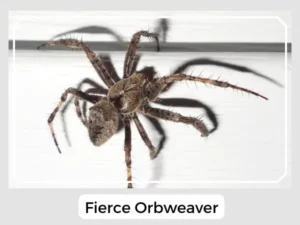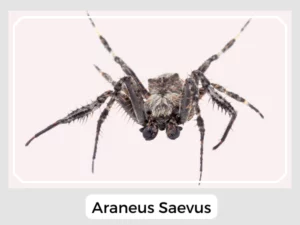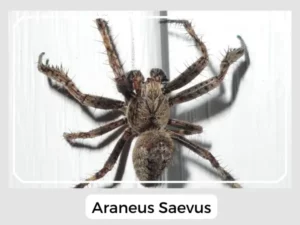The fierce orb weaver spider spins its web in interesting patterns. Part of the orb weaver spider family, it looks a lot like the Araneus nordmanni. Get ready to uncover cool facts about this spider right here!

Photo Credit: Andrew Block
This spider overwinters in the eggs stage.
These spiderlings are yellow.
This spider weaves webs between spruce branches at various heights, 150 cm above the ground. It is strong and not dense.
Yes, fierce orbweaver spiders have venom, but it’s mostly harmless to humans. Their venom helps them catch and eat their prey.
Yes, they can bite, but it’s rare. If they do, it’s usually not harmful to humans and feels like a pinprick.

Photo Credit: Gilles Arbour
The fierce orb weaver plays a significant role in the ecosystem as a natural pest controller. By catching and consuming flying insects such as crane flies and moths, they help to regulate insect populations, thus maintaining the balance within their forest habitats.
Natural Predator: This spider’s natural predators include birds and larger insects, which help to keep its population in check and prevent overpopulation of any one species within the forest ecosystem.
Prey-Predator Dynamics: The fierce orb weaver is an integral component of the food web. It serves as both a predator to smaller insects and as prey to larger animals. This dynamic illustrates the balance of nature, where each species plays a role in sustaining the ecosystem.
Relationship with Humans: Interactions between fierce orb weaver spiders and humans are infrequent and usually harmless. While they possess venom, it is not potent enough to cause harm to humans, and bites are both rare and minor.

Photo Credit: Andrew Block
| Lifespan | Around 1 year |
| Distribution | Canada and the northern United States, Russia, as well as other parts of Europe |
| Habitat | Forests |
| Diet | Flying insects like crane flies and moths |
In conclusion, the fierce orb weaver spider is an essential predator within its ecosystem.
The fierce orb weaver spider spins its web in interesting patterns. Part of the orb weaver spider family, it looks a lot like the Araneus nordmanni. Get ready to uncover cool facts about this spider right here!

Photo Credit: Andrew Block
This spider overwinters in the eggs stage.
These spiderlings are yellow.
This spider weaves webs between spruce branches at various heights, 150 cm above the ground. It is strong and not dense.
Yes, fierce orbweaver spiders have venom, but it’s mostly harmless to humans. Their venom helps them catch and eat their prey.
Yes, they can bite, but it’s rare. If they do, it’s usually not harmful to humans and feels like a pinprick.

Photo Credit: Gilles Arbour
The fierce orb weaver plays a significant role in the ecosystem as a natural pest controller. By catching and consuming flying insects such as crane flies and moths, they help to regulate insect populations, thus maintaining the balance within their forest habitats.
Natural Predator: This spider’s natural predators include birds and larger insects, which help to keep its population in check and prevent overpopulation of any one species within the forest ecosystem.
Prey-Predator Dynamics: The fierce orb weaver is an integral component of the food web. It serves as both a predator to smaller insects and as prey to larger animals. This dynamic illustrates the balance of nature, where each species plays a role in sustaining the ecosystem.
Relationship with Humans: Interactions between fierce orb weaver spiders and humans are infrequent and usually harmless. While they possess venom, it is not potent enough to cause harm to humans, and bites are both rare and minor.

Photo Credit: Andrew Block
| Lifespan | Around 1 year |
| Distribution | Canada and the northern United States, Russia, as well as other parts of Europe |
| Habitat | Forests |
| Diet | Flying insects like crane flies and moths |
In conclusion, the fierce orb weaver spider is an essential predator within its ecosystem.